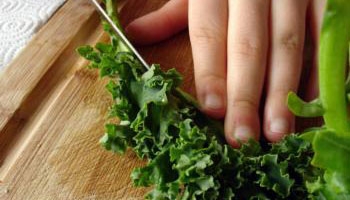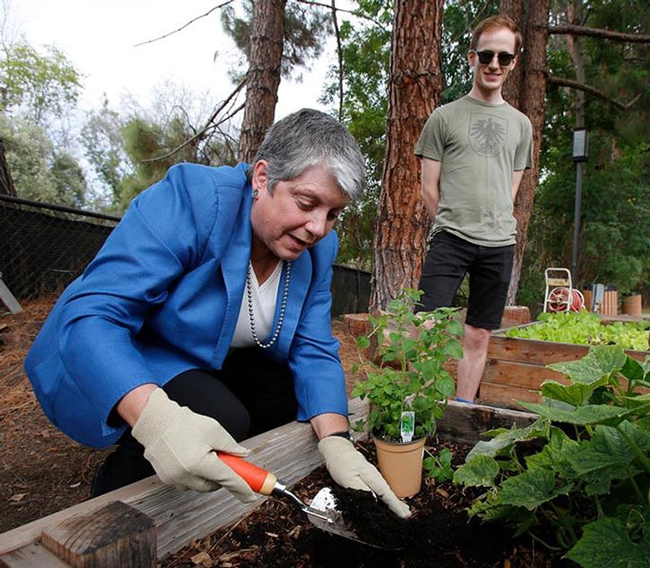Posts Tagged: Obesity Prevention
Twenty questions that can predict obesity
By asking 20 simple questions about family eating habits, health professionals can help predict the likelihood that young children will become overweight or obese in the future, according to research by UC Agriculture and Natural Resources (UC ANR) scientists.
This knowledge allows professionals to quickly identify where interventions are needed to change behaviors before the children end up with chronic diseases caused by an unhealthy trajectory of weight gain.
The project was a collaborative effort involving the nutrition science laboratory of Marilyn Townsend, UC Cooperative Extension specialist based at UC Davis, and UC Cooperative Extension's Expanded Food and Nutrition Education Program educators. Funding was provided by grants from USDA and UC ANR.
The 20 questions came from a much longer Healthy Kids survey. In creating the survey, the scientists focused on young children in low-income families, which are disproportionately affected by the obesity crisis. The USDA is troubled by statistics that show that, over the last three decades, the rate of overweight and obesity has risen consistently.
Organizations that work with low-income families are eager to determine which families need help to modify their at-home eating practices to ensure a healthier outcome for the children. The wording of the initial versions of survey questions were identified by poring over dozens of peer-reviewed published research reports. Townsend and her staff then conducted numerous interviews with parents to reword questions so that those with literacy issues could understand the meaning as researchers intended.
“Parents have control over the children's environments. They buy the food and serve it. We looked at what parents are doing that might be impacting obesity,” Townsend said.
The researchers identified 23 dietary decisions that parents were making that seemed to contribute to their children's weight gain. The researchers then wrote 48 questions to gauge the 23 behaviors.
Developing an effective questionnaire involved extensive research and testing. Ultimately, the most effective format included pictures that looked like family snapshots, not stock photos, simple language and multiple choice questions. The survey was made available online to agencies that work with low-income families. It works, but it's long.
Streamlining the survey became the Townsend lab's next order of business.
Working with UCCE nutrition, family and consumer sciences advisors, the team recruited 170 children between 2 and 5 years old and their parents. They measured the children's height and weight and took blood samples at three times during the four-year study. The parents also completed the 48-question survey.
“By tracking height and weight, and comparing the changes over time, we got a clear picture which children were on an excessive weight gain trajectory,” Townsend said. “With the blood samples, we were able to look for biomarkers that are indicative of inflammation, which are related to choices in the family environment.”
Using sophisticated statistical analysis, the scientists were able to identify the 20 questions that were most indicative of unhealthful weight gain and higher incidence of biomarkers that indicated low grade inflammation in the children's blood.
|
The 20 questions are:
|
Research and outreach support culture of health and fitness
The small, mostly Mexican-immigrant Central Valley community of Firebaugh has been at the center of an extensive UC Agriculture and Natural Resources (UC ANR) research and outreach project that is aiming to reduce the incidence of childhood obesity, reported Alexandra Wilson on the USDA Blog.
The project, called Niños sanos, familia sana (Healthy children, healthy family) has turned into a community-wide effort and a new culture of health for families. Lucia Kaiser, UC ANR Cooperative Extension specialist, is leading the project. Outreach involves UC ANR Cooperative Extension advisors and staff in Tulare, Yolo, Kern and Fresno counties and the UC CalFresh and EFNEP programs.
According to the Centers for Disease Control and Prevention, childhood obesity has more than doubled in children and quadrupled in adolescents in the past 30 years.
“The lasting impact that Niños Sanos, Familia Sana will have in Firebaugh is precisely the goal of the childhood obesity prevention program – working at the family, school, and community levels to make healthy kids and healthy families a part of everyday life,” said Deirdra Chester, NIFA's national program leader for applied nutrition research.
According to the USDA blog post, Niños sanos, familia sana has contributed to changes in the community:
- Slower weight gain among obese boys
- Reduction in children's consumption of high-fat/high-sugar foods
- Growing interest in programs and policy reflecting local commitment to improved health and nutrition
For more information, see a story and video snapshot in the UC Food Blog.
President Napolitano launches UC Global Food Initiative
On July 1, the University of California announced our new Global Food Initiative to address one of the critical issues of our time: How to sustainably and nutritiously feed a world population expected to reach eight billion by 2025.
UC's Division of Agriculture and Natural Resources is already a critical partner with California's farmers and consumers, providing growers and ranchers with scientifically tested production techniques, educating families about nutrition, improving food safety and addressing environmental concerns. With programs in every California county, our research and extension network in California reaches from Tulelake to El Centro and more than 130 countries working to solve agricultural problems at home and abroad.
The initiative will align the university's research, outreach and operations in a sustained effort to develop, demonstrate and export solutions — throughout California, the U.S. and the world — for food security, health and sustainability.
Check below for some key highlights from UC ANR and our 10 campuses. For more information about the initiative, visit: http://www.ucop.edu/initiatives/global-food-initiative.html
UC ANR
- In the past 10 years, 500 million citrus trees have been grown from disease-free budwood provided by Lindcove Research and Extension Center (REC).
- Desert REC has 1,300 carrot varieties in production for USDA's carrot improvement program.
- California became one of the leading producers of fresh blueberries after UCCE researchers identified varieties that could thrive in California, so long as the growers acidify the soils and maintain acidic conditions in the irrigation water.
- 5,400 UC Master Gardener volunteers play a key role in helping Californians grow food in their own backyard, working in 50 California counties to teach research-based gardening techniques that minimize the use of pesticides and artificial fertilizers. Currently, more than 1,200 community, school and demonstration gardens in California are managed by UC Master Gardeners.
- Through our Expanded Food and Nutrition Education Program (EFNEP) and UC CalFresh Nutrition Education Program (also known as SNAP-ED), UC Cooperative Extension works with community agencies and schools todeliver nutrition education to low-income families, improving their health and food security and helping preventchildhood obesity. EFNEP and CalFresh programs are currently operated in 33 counties reach 222,000 members of the public each year.
UC Berkeley
- The Berkeley Food Institute (BFI) is an interdisciplinary institute launched in 2013 dedicated to research, education, policy initiatives and practices to support sustainable food and agriculture systems. BFI is catalyzing and fostering transformative changes in food systems, to promote resilience, justice, diversity and health, from local to global scales.
- The Atkins Center for Weight and Health (CWH) works with community groups to develop and evaluate programs to support healthy eating and active living, with a focus on children and families in diverse communities.
UC Davis
- As the largest UC campus, with more than 3,000 acres specifically devoted to agricultural research and teaching, UC Davis is addressing the pressing food and agricultural challenges that face California, the nation and the world.
- In addition to the World Food Center, UC Davis hosts 26 centers with a significant emphasis on agriculture and food, including the UC Agricultural Issues Center, Agricultural Sustainability Institute, Center for Produce Safety, Foods for Health Institute, Seed Biotechnology Center, Postharvest Technology Center, Plant Breeding Center, Giannini Foundation of Agricultural Economics, Center for Food Animal Health, and Robert Mondavi Institute for Wine and Food Science.
- In April, UC Davis unveiled the largest anaerobic biodigester on a college campus, using technology invented by one of its engineering professors to turn organic waste into renewable energy. The system, now in commercial use, is designed to daily convert 50 tons of organic waste to 12,000 kWh of renewable electricity, diverting 20,000 tons of waste from local landfills each year.
UC Irvine
- Anthropologist Michael Montoya leads the Community Knowledge Project, an action-research partnership with community organizations in Santa Ana. Past projects have tackled obesity prevention and school lunch/food access. Upcoming project on diabetes prevention in Fullerton.
- In AY 2014-15, the Sustainability Initiative, in conjunction with social ecologist John Whiteley and UC Irvine's oceans faculty, will host a regional conference at the National Academies of Sciences' Beckman Center on Ocean Health, Sustainable Fishing, and Food Security.
- The Sustainability Initiative convenes The Garden Project, which coordinates the four campus community gardens (three of which are student-run) and builds links with the broader community involved in sustainable food production in Orange County, particularly in low-income communities.
UCLA
- The UCLA Center for Health Policy Research and the UCLA–USC Center for Population and Health Disparities — among other centers — are actively involved in research and community projects to help improve food availability and security.
- The Student Food Collective holds farmers markets in UCLA's main plaza and manages a food-buying co-op. Multiple produce gardens on campus increase sustainability practices, provide more healthful options and serve as educational tools to facilitate healthy lifestyle choices by the campus and surrounding community.
- The UCLA Mildred E. Mathias Botanical Garden promotes plant diversity and ecologically sound practices.
- UCLA faculty, students and staff collaborate with LAUSD food services and medical staff on research and programs to promote healthy eating for the school district's 600,000 students.
UC Merced
- Public Health Professor A. Susana Ramirez and her students this summer will interview with customers at a mobile farmer's market that travels to different parts of Merced County to better understand food access issues facing Merced County residents, and the relationship between access to healthy foods and obesity.
- UC Merced is working to form a Farmers Consortium to promote the campus's interest in doing business with local farmers, in addition to direct communication with local farms.
- UC Merced's 400-square-foot community garden was developed on campus in spring 2014 by Engineers for a Sustainable World. Fruit and vegetables harvested will be donated to local food banks. The site will eventually be used for education and outreach.
- The campus's Early Childhood Education Center serves as a delivery point for Rancho Piccolo, a community- supported agriculture. Many faculty and staff are members and are able to get local, fresh fruit and vegetables every week.
UC Riverside
- A chemist has applied chemical tests to juice products sold as pomegranate juice or pomegranate juice blends, in order to authenticate their content. Another researcher is studying the effects of pomegranate juice on prostate cancer progression.
UC San Diego
- Food and Fuel for the 21st Century supports the development of innovative, sustainable and commercially viable solutions for the renewable production of food, energy, green chemistry and bio-products using photosynthetic organisms — including converting solar energy into food and fuel, without the use of fossil fuels.
- Department of Literature students can enroll in “The Politics of Food” course that utilizes UC San Diego campus gardens for summer research. Students learn how community gardens are governed, planting their own seedlings and identifying campus markets for the produce they grow. In the Division of Biological Sciences, courses such as “Fundamentals of Plant Biology” introduce students to plant genetic engineering, plant disease and stress and sustainable agriculture.
- The UC San Diego School of Medicine's Child Development and Community Health program initiatives include Network for a Healthy California: Campaigns and programs focus on increasing fruit and vegetable consumption, physical activity levels and food security among low-income families. Healthy Works: This program initiates new farmers markets, promotes additional school and community gardens and helps residents to stay physically active and eat nutritious foods.
UCSF
- In 2009, UCSF launched the Smart Choice Smart U program http://smartchoice.ucsf.edu) in partnership with MyFitnessPal, a leading mobile application and website and Fitbit, an activity tracker, that combines food tracking with physical activity to give real-time feedback about personal wellness goals.
UC Santa Cruz
- The Center for Agroecology & Sustainable Food Systems (CASFS) at UC Santa Cruz has developed cutting-edge programs in food systems and organic farming research and extension, national and international work in agroecology, and a renowned apprenticeship program.
- The nearly 1,500 graduates of its Apprenticeship in Ecological Horticulture have carried hands-on experience into teaching, farming and advocacy positions worldwide for more than 45 years.
- An on-site affiliate, Life Lab, uses the Farm for K–12 school tours, teacher trainings, summer camps, and the “Food What?” youth empowerment program.
- The Central Coast School Food Alliance (CCSFA) is a collaborative initiative that serves school children fresh and wholesome food in Santa Cruz, San Benito, and Monterey counties. Stakeholders include food service directors, non-profit leaders on community food systems development, researchers, educators, as well as elected local, state, and federal officials.
Kids drop pounds, eat more veggies with nutrition program
The percentage of overweight or obese children in test schools dropped from 56 percent to 38 percent over the course of a single school year, thanks to a new nutrition program developed and tested in the classroom by nutrition researchers at the University of California, Davis.
The new program fits into the new Common Core educational standards.
"The education component of this program is intended to help children develop nutrition-related problem solving skills," said co-author Jessica Linnell, a senior doctoral candidate in the UC Davis Department of Nutrition. "We think that these skills, combined with knowledge about foods, may be critical in order for children to make healthy choices."
Researchers say the program could be adopted nationally at little cost to schools. The program was pilot-tested for this study in schools located in Sacramento and Stanislaus counties. Study findings were reported recently during the Experimental Biology 2014 meeting.
"When we designed the study, we anticipated short-term outcomes such as kids having more knowledge of nutrition or being able to identify more vegetables," said Rachel Scherr, assistant project scientist in the UC Davis Department of Nutrition and one of the study's lead investigators. "We always had a long-term goal of decreasing body mass index, but we didn't anticipate that it would happen in such a short timeframe, so we are thrilled."
In a randomized control study, the researchers found that fourth-graders who participated in the nutrition program ate substantially more vegetables and lowered their body mass index during the school year that the nutrition program was implemented.
Senior author Sheri Zidenberg-Cherr, a Cooperative Extension specialist In the Department of Nutrition and co-director of the UC Davis Center for Nutrition in Schools, said that the project could not have been possible without the work of a highly interdisciplinary team, including collaborators from University of California Agriculture and Natural Resources; the UC Davis departments of Nutrition, Human Ecology, Population Health and Reproduction, and Plant Sciences; the UC Davis Health System, Betty Irene Moore School of Nursing, Foods for Health Institute and Agricultural Sustainability Institute; and the University of Utah Department of Physics and Astronomy.
The study was funded by a UC Division of Agriculture and Natural Resources Competitive Grant.

Fourth-graders who participated in the nutrition program ate more vegetables.
UC is bolstering family health in Mexican-American communities
Mexican-American families in Firebaugh, Calif., are getting together regularly with University of California nutrition educators this summer to learn ways to enhance their families’ diets with fresh fruits and vegetables. Meanwhile, the children are introduced to fun activities planned around healthy eating and physical activity.
The program, called Niños Sanos, Familias Sanas (Healthy Children, Healthy Families), is part of an extensive five-year research and outreach project that got underway last fall designed to help nutrition specialists understand the best way to slow the rate of obesity among Mexican-American children.
Researchers include students, specialists, and professors from the UC Davis departments of Nutrition, Chicano Studies, Agricultural Resource Economics and Human Ecology, and the UC Davis schools of Medicine, Nursing and Education. Outreach involves UC Cooperative Extension advisors and staff in Tulare, Yolo, Kern and Fresno counties and the UC CalFresh and EFNEP programs.
“Mexican-American children have a high rate of excessive weight gain that could lead to obesity as teens and as adults,” said Lucia Kaiser, UCCE specialist in the Department of Nutrition at UC Davis and a project leader. “We want to see if we can normalize their weight gain by increasing their consumption of fruits and vegetables and encouraging physical activity.”
For comparison purposes, the researchers are offering educational programming that does not focus on nutrition in another San Joaquin Valley community with a high Mexican-American population. While the Firebaugh families are learning about the importance of family meals, how to read nutrition labels and getting a $25 monthly stipend to purchase produce, families in the city of San Joaquin and surrounding communities are getting together to learn about parenting, mental health, financial management, school achievement and other topics of interest to the participants.
Twice a year, the researchers measure the height and weight of children from both communities and collecting data about their household habits. At the end of the study, the researchers will be able to see whether the nutrition intervention had an impact on the children’s health.
In addition, Kaiser said, the project team is working with the local school district to maintain the physical activity and wellness components of the project, plus a new farm-to-school initiative, once the research funding is exhausted.
“Through this research, the UC Cooperative Extension nutrition educators are developing relationships in these communities,” Kaiser said. “We expect to be able to sustain these healthy programs into the future.”
See a video snapshot below:






